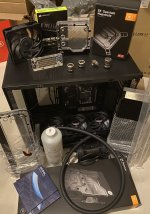Thanks again. I was able to remove the back plate without destroying any of the thermal pads. I've cut a piece out of a slot cover and used it as a punch disc, in order to attach a second bolt from the back. luckily they are short enough to not push each other out of that thread. The bolt on the top side is attached with less tension. I think it will work.
That looks pretty good to me! Nice thinking!






